Organists of Old First | 4: William G. Hammond (1903-1912)
Curious who wrote the Polytechnic Institute alma mater? Our fourth organist, William Gardiner Hammond, was a highly successful musician and composer, well-connected and well-known during his lifetime.
William Gardiner Hammond, was born Melville, Long Island, August 9, 1874, to parents George Tillinghast Hammond and Mary Elizabeth Shipman. His father was from an old Rhode Island family with Quaker ties, his mother from Long Island City, Queens. William was named after George’s father. George Hammond was proprietor and editor of The Daily News in Newport. Later, when he relocated to New York City, he continued to write while holding a position as Deputy Collector of the Port of New York. He also held various public offices, but never let go his ties to Newport. There were eight sons and two daughters; one of the sons, lawyer Henry Bull Hammond, was William’s twin. Soon after George died in 1897, Mary removed to Brooklyn with the children. William was 22.
Studies and Early Career
William Hammond studied at the New York Conservatory of Music and privately under Herr August Spanuth of Berlin. Spanuth spent significant time in New York, and was a frequently published music critic in both the U.S. and Germany.
At the age of 16, William was named organist of the old Trinity Church in Newport, Rhode Island. Built in the 1700s, Trinity had been home to many notable clergy, the organist Charles Theodore Pachebel, and parishioners John Jacob Astor VI and Cornelius Vanderbilt II. (read more here)
Of the organ at Trinity, the church website says:
Up in the rear balcony is the organ; the center of the facade and faux front pipes are all that remain of the original instrument. The crown on the top of the organ case stands for Queen Anne, monarch when the church was built; the two bishop’s mitres stand for the Archbishop of Canterbury and the Bishop of London, under whose jurisdiction the colonial church fell. … Rumor has it that George Fredrick Handel tested and signed off on the organ in England before it was disassembled and shipped to Rhode Island. (see photo of organ here)
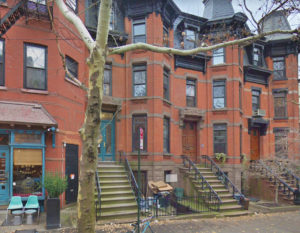
Hammond family home at 156 Berkeley Place. Image from Google Maps.
In 1892, Hammond’s mother and siblings were in Brooklyn, but not William or his father; he was 18 and likely at school. At the time of his father’s death in Newport, 1897, William was organist and choirmaster at St. Thomas Church on Bushwick Avenue in Brooklyn, and was still there in 1898. After, he held a position at St. Marks Church. 1900 finds William, aged 24, organist, living with his mother and five siblings at 156 Berkeley Place, in Park Slope. By 1901 he was organist at the esteemed Washington Avenue Baptist Church (now Brown Memorial Baptist Church).
[William Hammond] is organist and choir-master of the Washington Avenue Baptist Church, one of the most prominent churches in Brooklyn, N. Y., and is leader and teacher in a number of musical societies. – History and genealogies of the Hammond families in America with an account of the early history of the family in Normandy and Great Britain, Frederick Stam Hammond, 1902, pub 1904.

Ad placed in “The Music World”, November 1903
Old First
In the early spring of 1903, William Hammond was named the organist and music director at Old First upon the departure of H. E. H. Benedict. In addition to his salaried work, he organized the Hammond Choral Society, which held regular evening and weekend practices and concerts in the Upper Hall. Previous organists and music directors had held performances at Old First but Hammond seemed to have taken it to a new level plus he had a large following in both New York and Rhode Island. Hammond had also begun to travel and to write music, some of which became very popular. He was in demand.
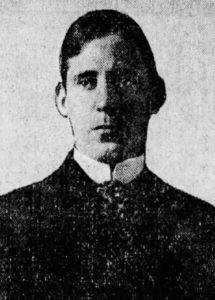
William Gardiner Hammond in 1912, from “The Brooklyn Daily Eagle”
On July 5, 1906 William was married in Neoga, Illinois, to Sara Binford Ragan, daughter of a physician. She was a singer, a contralto. He had met her the previous year during one of his summer sabbaticals, in Rochester, New York, where she studied music. Their only child, George Tillinghast, was born November 29, 1907.
2 May 1909 — The Brooklyn Daily Eagle
“William G. Hammond, the organist and choirmaster at Dr. Farrar’s, remains in charge of the music, but has been granted a leave of absence by the church, commencing next October, in order to study abroad.”
I have not discovered where “abroad” was, but on their return in April of 1910, William and his family took up residence in Manhattan before coming back to Brooklyn and Old First for another two years as organist and choirmaster. But the travel/study bug rose again, and we find this article in The Brooklyn Daily Eagle, dated April 27, 1912. Whether his brother James S. Hammond, a theatrical director, had any influence in William and Sara’s decision, is yet to be discovered, but he certainly had may connections in the field as a popular composer:
“William G. Hammond, one of the best-known organists and composers of Brooklyn, who has served at St. Thomas, St. Mark’s and Washington Avenue Baptist churches, and is now closing his ninth year of continuous service in the First Reformed Church, Seventh avenue and Carroll street, of which the Rev. Dr. James M. Farrar is pastor, has concluded to give up church work and go abroad. He will devote his time to the study of the dramatic in music and to writing opera, hoping to finish a work which he feels he could labor upon under more inspiring environment in Italy…and also that his wife, who has a remarkably fine contralto voice, …might be able to pursue her vocal studies under Lombard in in Florence.
Mr. Hammond and his wife will be missed in local musical circles, where both have long been known as musicians of a high order. In many of the churches Mr. Hammond’s compositions have been sung, and one of his cantatas, “Messiah Victorious,” has become a favorite. The close of his nine years of continuous service in the First Reformed Church will be commemorated by a special musical programme tomorrow night, consisting entirely of his own sacred compositions. Mr. Hammond is widely known for his sacred writings, all of which have been great favorites in the church where he played so long, and the giving of an entire programme of his work is at general request.
The congregation at Dr. Farrar’s church holds the retiring organist in high esteem. The programme for the service tomorrow evening will be given by the quartet under Mr. Hammond’s personal direction, and will be as follows:
Organ prelude “Improvisation”; anthem, prologue to Easter Cantata, “Messiah Victorious”; tenor solo, “Thy Life Was Given for Me”; contralto solo, “Behold the Master Passeth By“; bass solo, “Invocation”; soprano aria, “Behold How Peaceful Dawns the Day,” from “Messiah Victorious.”
At the time of his departure to Europe in 1912, the Daily Eagle reported that he had served the First Reformed Church for 12 years, overlapping both Rafael Navarro and H. E. H. Benedict. He gave his last performance at Old First on April 27, 1912.
Composer

Lillian Nordica as Brünnhilde, 1898
Around the time of his arrival at Old First, William G. Hammond began to publish his own compositions, both secular ballads and religious. Listen to “Behold the Master Passeth By,” composed in 1905, which was shared in an earlier blog post. Also at this time, William accompanied singer Lillian Nordica, described as America’s first home-grown diva. She became a fan of Hammond’s and introduced many of his early songs, a boon to his career.
“Mr. Hammond’s Songs”
William G. Hammond, the director of the music at the First Reformed Church, where his Hammond Choral Society gave the first of two concerts, on Wednesday evening of this week, has issued a very unusual brochure called “The Songs of William G. Hammond.” Opening with a letter from Lillian Nordica in which the great diva speaks of her success in singing his two German songs, “Wenn ich in Deine Augen she” and “Im wunderschoenen Monat Mai” on one of her concert tours, there is further reference to this singer’s appreciation of his “Du bist wie eine Blume,” which she has called one of the best of modern songs, “Cloud Shadows” and “Love’s Springtide.” There is also mention of the singing of “Cloud Shadows” and “The Ballad of the Bony Fiddler” by David Bispham in London and of the singing of his “Recompense” by Charles W. Clark in Paris as a representative American song, Gadski [German opera singer who sang as a soprano at the Metropolitan Opera from 1898 to 1904 and again from 1907 to 1917], as well, has given prominence to some of Mr. Hammond’s songs on her concert programs. Following these appreciative mentions is a complete descriptive list of Mr. Hammond’s work as a composer of songs—and a notable list it is. — 15 Dec 1906, Brooklyn Life
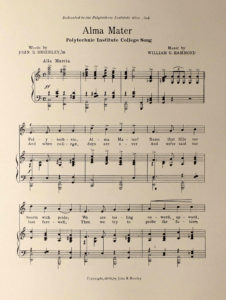 Hammond composed the alma mater, “Polytechnic Institute College Song,” in 1909 with words by John R. Brierley, ’10. “Messiah Victorious” was one of Hammond’s most famous compositions during his lifetime. I have not found a copy.
Hammond composed the alma mater, “Polytechnic Institute College Song,” in 1909 with words by John R. Brierley, ’10. “Messiah Victorious” was one of Hammond’s most famous compositions during his lifetime. I have not found a copy.
Links to William G. Hammond’s discography and musical scores can be found at the end of this story here.
Return from Europe
A year later, in April of 1913, Hammond and his family returned from Genoa, Italy, and resumed their lives in Brooklyn and Watch Hill. In 1914, William’s youngest brother Charles Frederick Hammond, married Sara’s sister, Lucia Faris Ragan in the Hammond home at 156 Berkeley Place, where Sara sang Schumann’s “Lied der Braut” (The Bride’s Song) and William accompanied on piano, Herbert Corduan on violin. Charles Hammond held a law degree, was a publisher of society weeklies; the Seaside Topics in Watch Hill, Rhode Island (and social directory), the Winter Park Topics in Florida, directed publicity for the Bach Festival in Winter Park, and contributed social news to the New York Herald-Tribune. He had a fine tenor voice, taught singing, and was a major participant in William’s musical life.
Watch Hill, Rhode Island
As early as 1908, one can find articles about Hammond concerts and summers spent at Watch Hill. These social and professional interludes had become a big part of the Hammond’s life. According to The New York Times, Watch Hill was historically home to “a select group of wealthy families” whose lives revolved around “golf and tennis at the Misquamicut Club, bathing and yachting at the Watch Hill Yacht Club, and tea and cocktails at Ocean House and Watch Hill’s other grand hotels.” The town, though wealthy, was staider than the opulent Newport nearby. From Albert Einstein to Hollywood stars, it was (and still is) a familiar retreat for the wealthy. The earliest summers were spent at the Ocean House. Later years the Hammonds performed at the new Watch Hill House. William was charge of the music for Watch Hill Union Chapel, holding that position for many years.
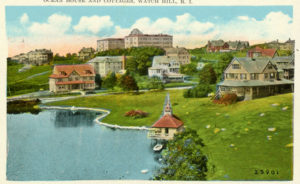
Ocean House dominates the horizon at Watch Hill, Rhode Island
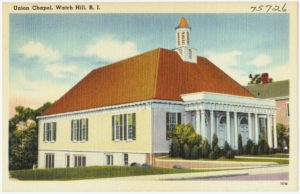
Union Chapel, Watch Hill
Organist at Flatbush Reformed Church
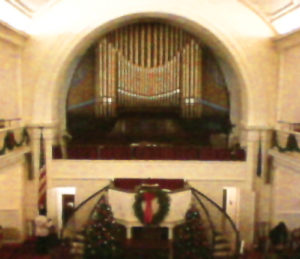
1897 George S. Hutchings Co. Organ at Flatbush Reformed Church. Photo: Jim Henderson
I am not sure when William Hammond began his position with the Flatbush Reformed Church. In his obituary, The New York Times says that he was 30 years there (1915), but The Brooklyn Daily Eagle said 25 years at Flatbush and before that, at Old First, which fits the timeline already established, so 1920 seems the most correct year for his start date. We do know that by 1920 Hammond was living near the church on Parkside Avenue in Brooklyn, his brother Charles and wife with them. By 1930 the Hammonds had moved into Manhattan, where they lived at 518 West 111th Street, in Morningside Heights. By 1940 they had moved to 212 East 39th Street.
Sudden Death
On December 21, 1945, William was on the way to the post office to mail Christmas packages when he was struck by a car while crossing Lexington Avenue at 34th Street. He died two days later.
Obituary in The New York Times
…He was widely known for his choruses for male voices, “Lochinvar” and the “Liberty Bell” and for a song, “Pipes of Gordon’s Men”…
Obituary in The Brooklyn Daily Eagle
Discography
“Im wunderschönen Monat Mai”, soprano vocal solo, with orchestra, 1911 on Victor.
“The Pipes of Gordon’s Men”, tenor vocal solo, with orchestra, 1915 on Victor, 1922 on Columbia.
“Under the Window”, female vocal solo, with piano, recorded on Victor, 1931
Eighteen musical scores by William G. Hammond.
. . .
The story of Charles Leech Gulick, the short-lived Old First organist and traveling recitalist, is posted here.
Our church historian, Jane Barber, has compiled a comprehensive history of our amazing organ, and the people who have played it.
(read Part 1 here) Organists of Old First | Intro: A History
(read Part 2 here) Organists of Old First | 1: Harris Cornell Meserole
(read Part 3 here) Organists of Old First | 2: Rafael Navarro
(read Part 4 here) Organists of Old First | 3: Henry E.H. Benedict
